How to Make Ma’amoul, a Date-Filled Cookie from the Middle East
Updated: Dec. 08, 2020
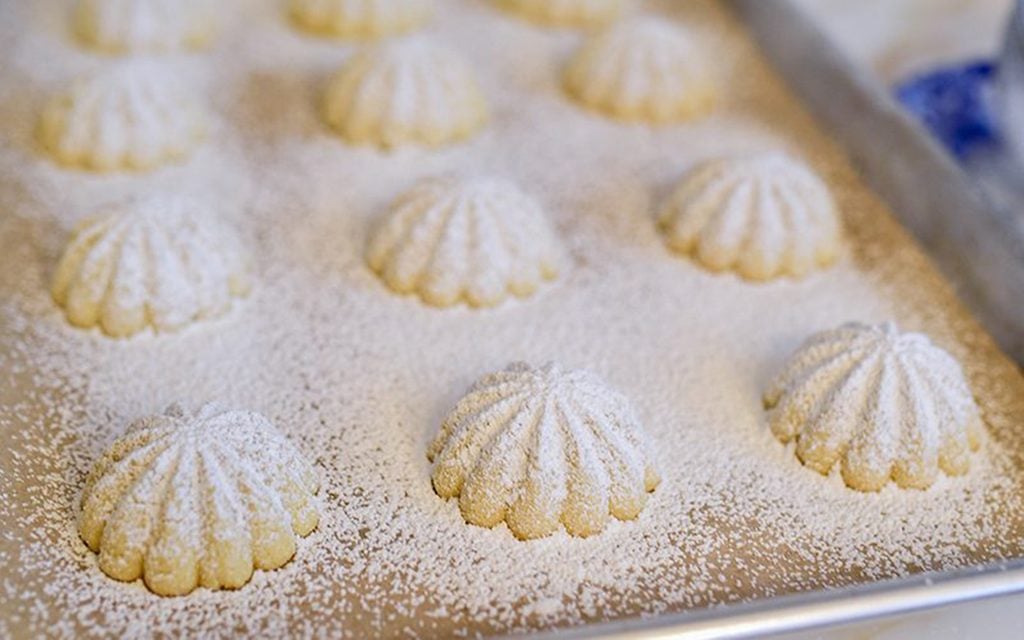
Learn how to make ma'amoul, the beloved Middle Eastern butter cookie, made aromatic with flower waters and filled with dates.
No DIY’er took food gifts more seriously than my Aunt Hilda. Her entrance on Christmas Eve, or any major holiday, was always dramatic: a beautiful top or dress, glamorous sunglasses, red lipstick. But her most dramatic accessory was a towering platter of ma’amoul. The molded, filled cookies were expertly arranged and stacked high like a pyramid, each cookie presented in its own foil cup. She wrapped the whole shebang with cellophane, tied with a bow.
Aunt Hilda’s ma’amoul was made in our family’s Lebanese tradition: a buttery, melt-in-your mouth cookie, filled with date paste or sugared nuts, and pressed into an heirloom wooden mold for a precise, gorgeous design and domed shape.
What Is Ma’amoul?
Bakers throughout the Middle East traditionally make ma’amoul cookies for holidays. They’re ubiquitous for Christians celebrating the end of fasting after Lent and for Muslims, Eid al-Fitr. The cookie is also a must, home- or bakery-made, at Christmastime or for events like weddings.
Ma’amoul’s famously rich outer cookie shell is made with flour, semolina or a combination of the two. Because semolina can be dry and crumbly, flour is often added to give the cookie staying power.
The other key ingredient for the dough—butter—must be clarified. The process is simple and though some recipes do not call for clarified butter, many agree it is essential to the texture of the cookie. Make clarified butter in advance to give it time to solidify at room temperature or in the refrigerator. Clarified butter stays good for months at room temperature in an airtight container; I keep it on hand at all times! You might think cultured butter, with its flavorful high fat content, would be ideal here. But I find it best to use a standard uncultured butter to encourage the dough to hold its shape.
Some recipes call for little to no sugar at all in the cookie, which complements the sweet date or nut fillings. Fragrant mahlab, an aromatic almond-like spice made from the kernel of the St. Lucie cherry, also contributes to the unique, delicate flavor of ma’amoul.
How to Make Ma’amoul
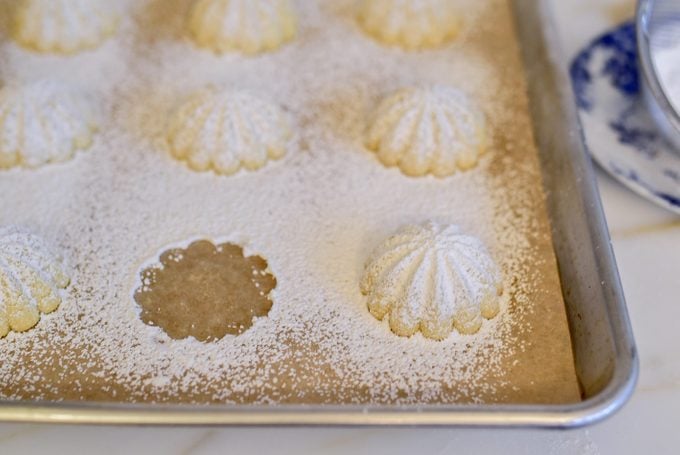
There is a “dance of the dough” that takes place in making ma’amoul dough! The dough-goal is a soft, pliable dough that doesn’t crack when shaped, but not so soft that the dough won’t release from the mold or lose its shape. It’s important not to overwork the dough, either, so squeeze some to understand how pliable the dough is, but take care not to overdo it. Keep a touch of milk and extra all-purpose flour on hand and add each by the tablespoon as needed to get the right results.
Here we’re filling the ma’amoul with dates, but scroll down for nut variations. Mahleb (also known throughout the Levant as mahlab, mahaleb, mahleppi and mahlebi) and flower waters are the hallmark pastry flavorings of the Middle East. Look for fresh-scented mahleb (this is what I use), and store it in the freezer. Avoid flower water “extracts,” as the flavor is not that of genuine flower water. Find excellent, pure flower waters here.
This recipe makes about 18 2-inch cookies.
Ingredients
For the cookies:
- 2 sticks unsalted butter (to make 3/4 cup clarified butter)
- 1/4 cup granulated sugar
- 1 large egg
- 1 teaspoon orange blossom water
- 1 teaspoon rose water
- 1-1/4 cups semolina
- 1-1/4 cups all-purpose flour, plus more as needed for the dough and to coat the mold
- 1 teaspoon mahleb
- 1-3 tablespoons whole milk, as needed
- 1/4 cup confectioners’ sugar, for dusting
For the date filling:
- 10 ounces date paste (also known as “baking dates”) or 10 ounces fresh pitted dates plus 1 tablespoon unsalted butter
Directions
Step 1: Clarify the butter
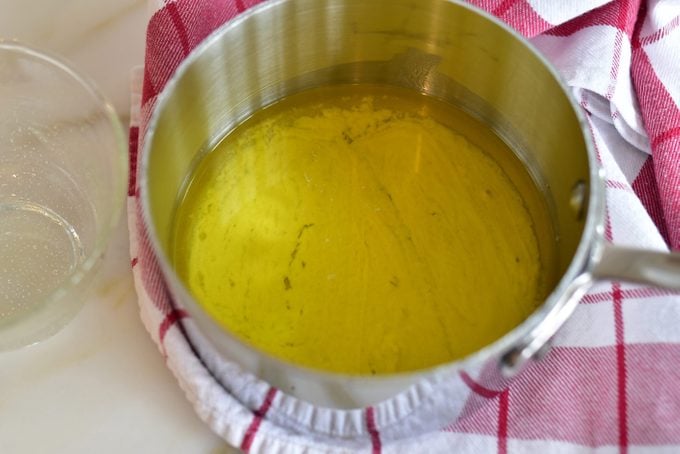
In a saucepan over very low heat, melt the butter undisturbed until completely melted, about 15 minutes. The solids will drop to the bottom of the pan. Pour off the golden clarified butter into a small bowl, which will be 3/4 cup, leaving the solids behind in the pan. Cool the clarified butter to solid room temperature (refrigerate to speed up the process).
Step 2: Make the dough
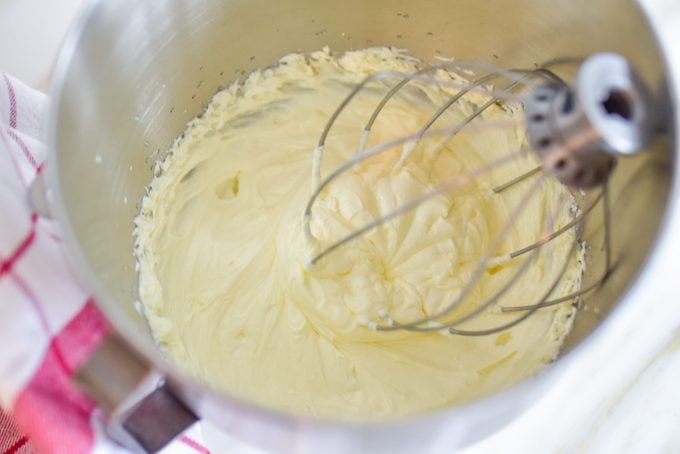
In a stand mixer or using a hand-held mixer, beat the butter in a large bowl until it’s creamy and light, about 3 minutes. Add the sugar, egg, orange blossom water and rose water. Beat again until the mixture is thick and creamy, another 3 minutes.
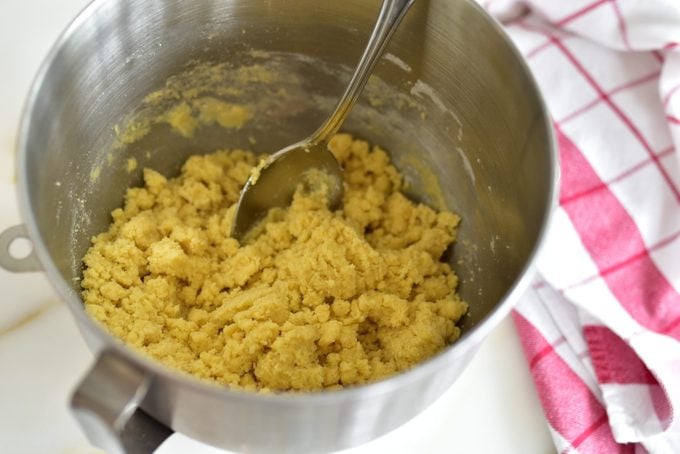
By hand, stir in the semolina, all-purpose flour and mahleb. The dough will be crumbly, but when squeezed should hold together without cracking. If the dough seems too wet, add more all-purpose flour 1 tablespoon at a time.
If the dough is dry and cracking, add milk, 1 tablespoon at a time, lightly stirring after each addition and squeezing a walnut-sized piece of dough in your hand to test how it holds together (looking for pliable and soft).
Allow the dough to rest for about 15 minutes, then squeeze a palmful again and adjust as needed to form a soft, pliable dough, taking care not to overwork the dough with your hands.
Step 4: Make the date filling
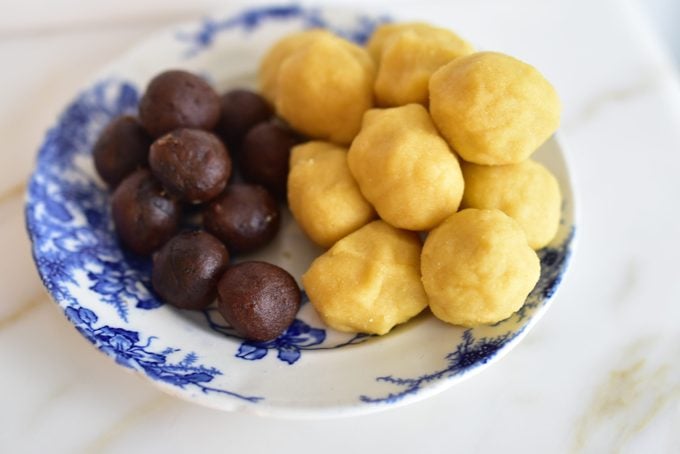
For the filling, if using fresh dates, finely chop them by hand or in the food processor. In a small saucepan over medium heat, cook the chopped dates with the butter, stirring until the dates are broken down to a paste. Cool.
Form this homemade or the premade date paste into small balls (coat your hands with a touch of oil or flour to prevent the date paste from sticking), using about 1-1/2 teaspoons per ball. The size of your filling depends on the size of your cookie, so adjust as needed. This is for a 2-inch cookie.
Step 5: Fill and shape the ma’amoul
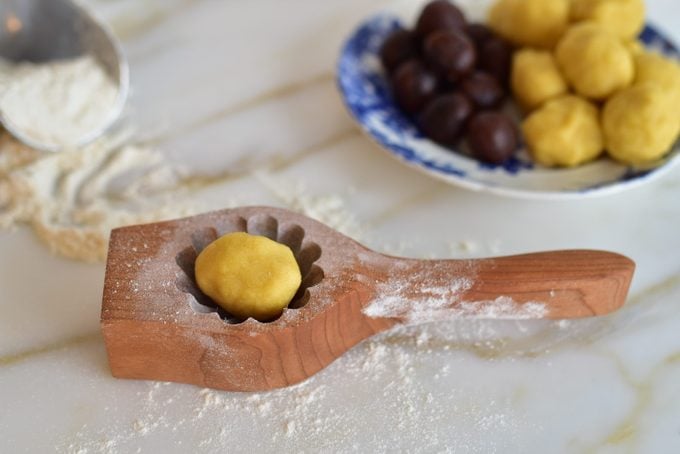
Move the oven rack to the top third of the oven. Preheat the oven to 350° F. Line two sheet pans with parchment paper.
To fill and mold the cookies, take a piece of dough about the size of a walnut (1 ounce), squeezing and shaping into a rough ball.
Coat the interior of a wooden ma’amoul mold with flour, knocking out the excess. Don’t skip this step! Do it every time dough is pressed into the mold; it’s essential for releasing the molded dough.
Place a ball of dough into the mold.
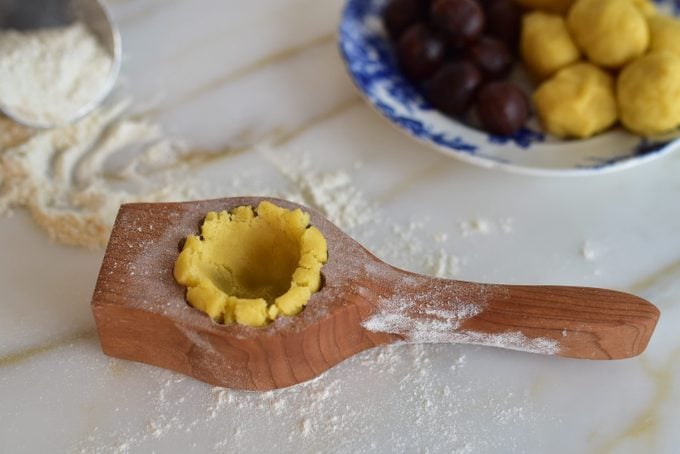
Press the dough ball into the mold, creating a hollow space in the center and pushing the dough up and over the perimeter edge. Fill the hollow with a date ball.
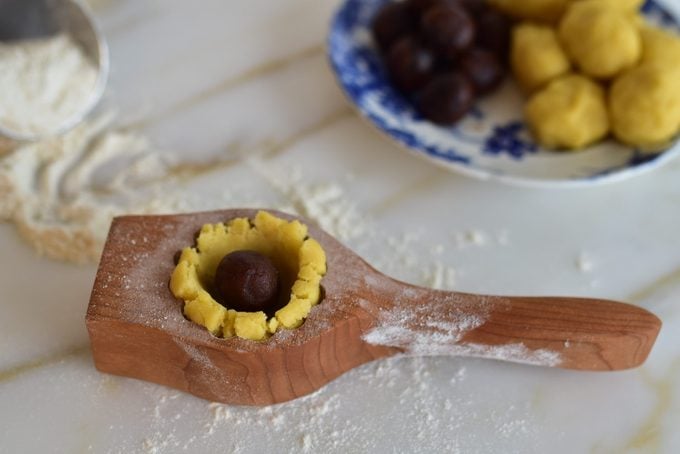
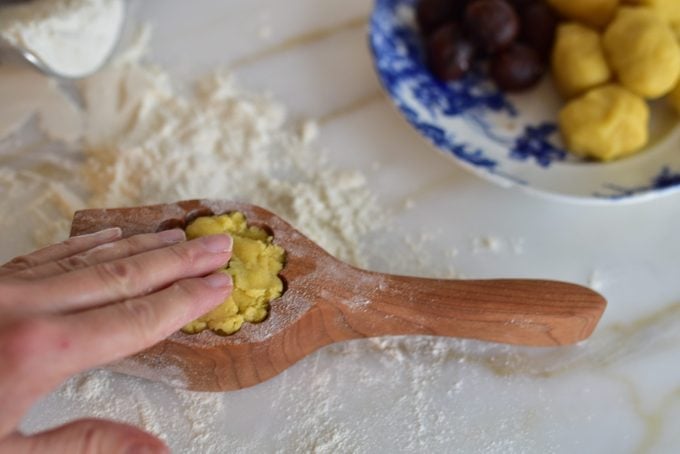
Cover the date ball with the dough, using a touch more dough as needed to seal the date ball inside the dough. Smooth the flat side of the dough numerous times with the palm of the hand.
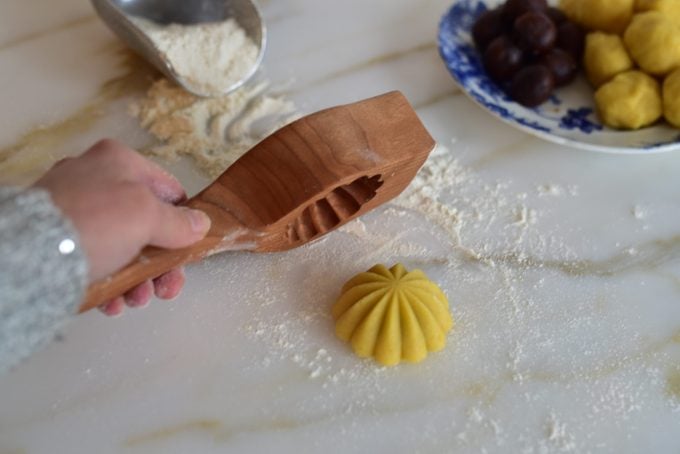
Turn the mold over and whack the top corner of the mold on the work surface once or twice to release the cookie. Place the cookie on the cookie sheet.
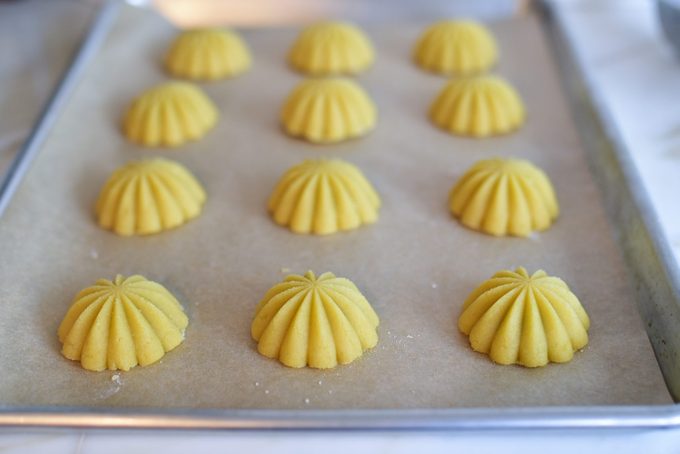
Repeat this process with the rest of the dough and date filling, placing the cookies about an inch apart on the baking sheets.
Step 6: Bake
Bake the cookies, one sheet pan at a time, for 15-17 minutes, or until the cookies are a pale golden brown. Keep an eye on the cookies to monitor if they are beginning to crack at the top. If the tops begin to crack, immediately remove the cookies from the oven. Place the hot sheet pan on a cooling rack and leave the cookies undisturbed until they are completely cooled. Sift confectioners’ sugar over the cookies.
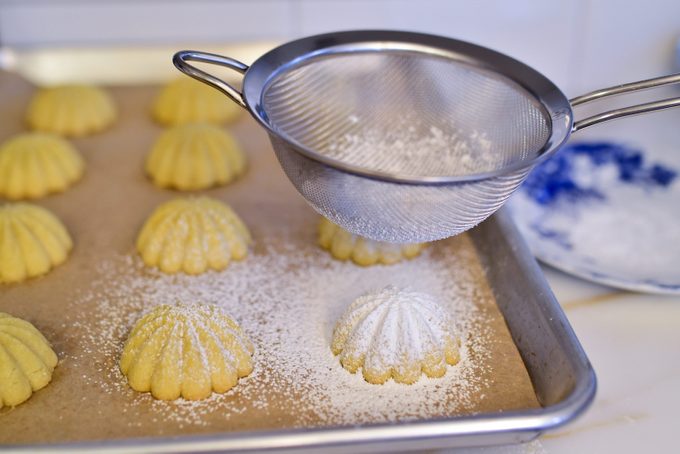
Store the cookies in an airtight container for up to two weeks at room temperature, or for two months frozen. Give the cookies a fresh dusting of confectioners’ sugar just before serving.
Ma’amoul Cookie Recipe Tips
Use different fillings
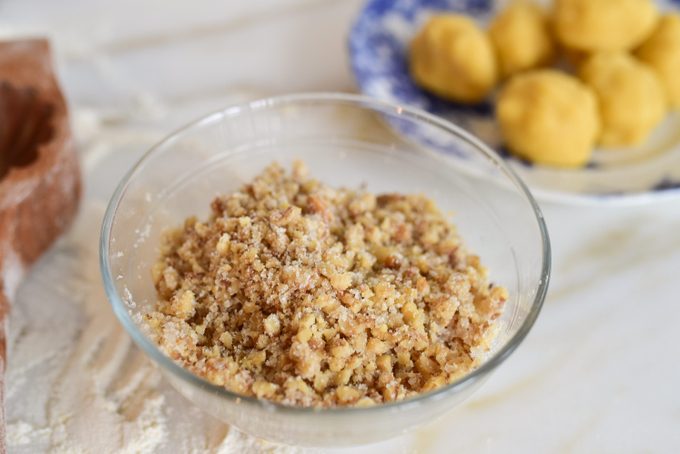
Nut fillings such as walnut or pistachio are as popular and delicious as the date. Be sure to toast the nuts first for best texture and flavor, then grind or finely chop them. Use about a cup of chopped nuts mixed with 1/4 cup granulated sugar and a teaspoon of orange blossom water. Fill the cookie dough with nuts using a teaspoon.
You will need a ma’amoul mold
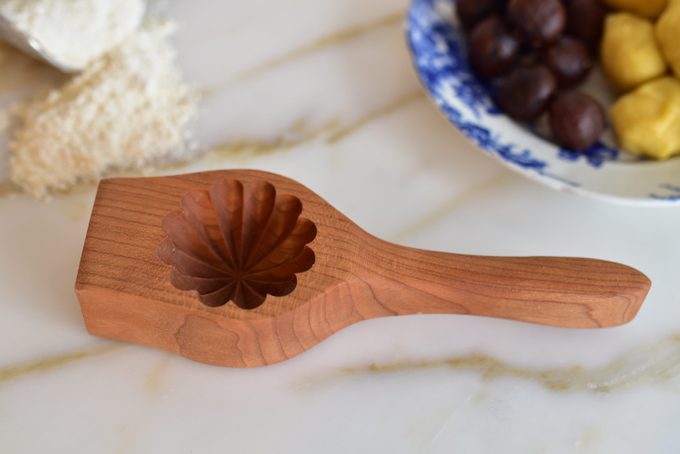
Molding ma’amoul is great fun and results in such a gorgeous cookie! But the molds found in Middle Eastern markets today are not like our grandmothers’ molds. They aren’t deep enough, and the design is typically not very well cut in the wood. I developed a wonderful mold that is the closest thing I’ve seen in quality to the vintage wood molds, for precise designs and depth of the imprint.
You can make ma’amoul ahead
Store the cookies in an airtight container for up to two weeks at room temperature, or for two months frozen. Give the cookies a fresh dusting of confectioners’ sugar just before serving.
